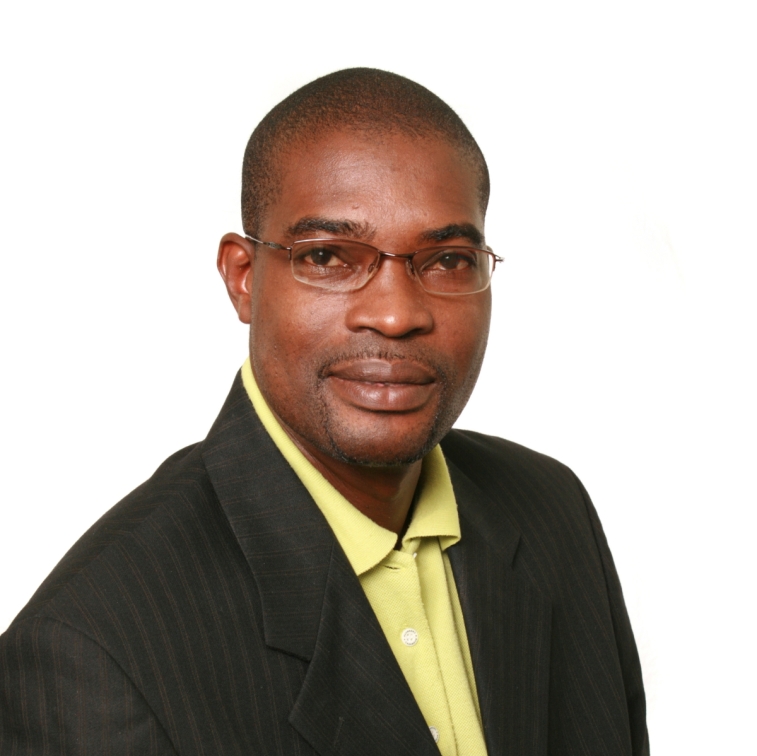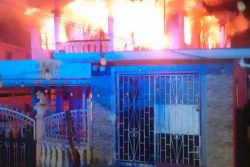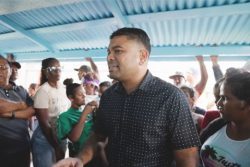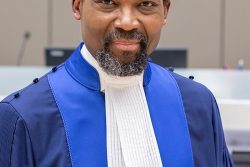Even as government continues negotiations with ExxonMobil for natural gas to come onshore by 2022 from oil extraction operations, it has simultaneously begun to prepare the infrastructure and has confirmed the landing location and generator types, Minister of Public Infrastructure David Patterson says.
ExxonMobil’s Country Representative Rod Henson on Friday informed that while the company believes it would be more beneficial monetarily to this country if all the natural gas was used for well injection purposes offshore, government has been in discussions with it to have some of the gas brought onshore for domestic use.
Given Guyana’s “unique” case where the cost of electricity from its current use of fossil fuels is “very high”, Henson noted, the company was working with government to bring a cleaner and cheaper alternative for this country’s domestic use. The amounts required, he said, would be around 30-35 million cubic feet of natural gas.
As such, he explained that discussions are ongoing towards this cause and if an agreement is reached soon Guyana could see natural gas being used in its energy mix by 2022. Pumping of oil from the Liza-1 well is expected to begin in 2020.
“I think our current view is, if we can do it in a timely fashion, get the environmental impact assessment and what’s not , we are likely looking at 2022, 2023 timeframe, plus or minus,” the ExxonMobil local head told a Parliamentary Committee on Natural Resources last Friday.
His views were echoed by Patterson, who told Stabroek News that even as the negotiations continue, government was preparing for the cleaner and cheaper alternative to heavy fuels, while it simultaneously put mechanisms in place to one day convert to renewable energy sources.
“That is a fair comment [the 2022-2023 projection by Henson]. The timeline is dependent on when we reach final agreement. We still have much to do, important things such as the EPA (Environmental Protection Agency) approval. However, the idea was always to have the units up and running before the gas is delivered,” the Minister of Public Infrastructure, who is responsible for energy, said.
‘Back up plan’
Patterson underscored the importance of not only being prepared for when the pipes land to shore but having a backup plan for the natural gas use. For this reason, he said, the generator sets that will be purchased will be dual-fuelled.
He explained, “A bit of background – generating sets normally come in sizes not much bigger than say 20 MW each, hence to have 200 MW it will require 10 sets in series. So the final configuration will have 18-20 sets. So as we have decided on a location, we intend to install say two or three, long before the natural gas arrives. These will be dual-fired so when the NG (natural gas) arrives, we will just flip the switch.
“The sets will be dual fuel. This is standard configuration without any significant cost. Two reasons, one is as mentioned the other is because when the natural gas is not available we will run on alternate fuel. This is the redundancy plan should the national gas not be available for any unforeseen reason. Always plan with a backup, that is what we are doing,” he added.
Having already identified Woodlands, Mahaica, East Coast Demerara as the location where the pipes will land, government has catered for part of a World Bank US$20M loan to be used to study the bringing of natural gas onshore for local energy needs.
“We have had desktop studies, but we now have to go further and actually work out the actual generation aspects onshore, what equipment for GPL (Guyana Power and Light) for example…there is a lot of work to get done. We have done an identification of the location, which is at Woodlands on the East Coast of Demerara but the work now in terms of for example, the pipeline, the width of the pipeline, say if 12 inches as opposed to 14 inches, where will it land, which company is going to take it there, is it General Electric, is it Wartsila, is it GPL by itself? These are decisions that have to be made and they can’t be made in a vacuum, so we need an in-depth study,” Trotman told reporters, after meeting with World Bank Representatives two months ago.
One of the desktop studies referred to by Trotman was undertaken last year by Mexican energy analysis company, Energy Narrative, costing some US$70,000.
Patterson had said that the studies had confirmed it was feasible to bring the gas onshore and that it would work out to about US 10 cents per megawatt hour.
“It has been confirmed that it is feasible. It has been confirmed that it will be an absolute benefit to the country, it has been confirmed, and I can say this, I will go out on a limb and say- the numbers are all sub US 10 cents per megawatt hour,” he told attendees at a GPL reception to welcome that company’s new Chief Executive Officer, last April.
‘Divert some’
Even as he stressed that no agreements have yet been reached, Exxon’s Country Manager on Friday said that similar studies undertaken internally by his company also showed it would be a feasible form of energy and negotiations continue with government.
“There are no agreements today and this gas and power project, I think you are talking about is under discussion. We have done our own study on this. As you may know, currently the reservoir development plan, which is in the public domain, is that all the gas will be reinjected into the reservoir. The reason you do that is, in reservoir management it is very common to do these types of developments and ultimately to get the most value from the resource by doing that. So Guyana will get more value by reinjecting that gas because it helps reservoir pressure, helps reservoir sweep and ultimately it helps you recover more oil. Now we have done some work that says that Guyana is in a unique position because of the high electricity costs and as far as the community, we have looked and seen how can we divert some of that gas to shore and that’s the project that is under discussion right now,” Henson said.
“There have been no agreements, there is no decision that I am aware of. But essentially, we have been talking with various government regulatory agencies. The project would be to divert 30-35 million cubic feet of gas from the Liza Destiny, build a pipeline to shore and then take that natural gas and burn that natural gas for electricity other than the heavy fuel,” he added.
‘No’
Asked by Chairman of the Committee, PPP/C MP Odinga Lumumba if the company has completed a study on the matter, Henson replied, “we have done much study work on this matter, absolutely… We have internal studies absolutely.”
But pressed further on if he could release that information to the Committee, he simply said, “No.”
Lumumba would probe further on the feasibility study and why the company did not want to give the committee a document on its research of the project.
“You are saying that is feasible and a study was done?” Lumumba asked.
“This is not difficult, in the realm of oil and gas. Sir, respectfully, you don’t need a feasibility study from a technical standpoint. This is very feasible,” Henson said.
“Technically and financially?” Lumumba queried to which Henson replied, “Yes”.
“You are not ready to give a document on this? The Chairman interrupted and again Henson said, “No”.
“Why not?” a seemingly puzzled Lumumba pressed on.
“Because we are not at that point yet. We are at the normal point of discussion; where it gets to be, how much it costs what capital investments, what power plants …all these things. We are not there yet,” Henson replied.
The line of questioning on natural gas was also diverted by committee member, PPP/C MP Pauline Sukhai, who for a second time asked the company about perceptions of being politically aligned as a partner in a natural gas venture which is a part of the APNU+AFC’s Green State Development Strategy.










